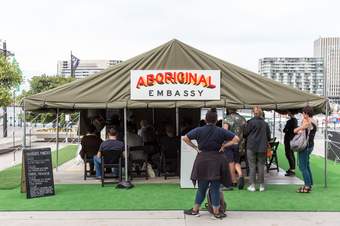
Richard Bell Embassy 2013-ongoing. Installation view, 20th Biennale of Sydney, MCS, 2015. Image courtesy of the artist and MCA. Copyright: The artist. Photograph: Daniel Boud

Richard Bell Embassy 2013-ongoing. Installation view, 20th Biennale of Sydney, MCS, 2015. Image courtesy of the artist and MCA. Copyright: The artist. Photograph: Daniel Boud
From 20 May to 18 June, Tate Modern will host Richard Bell’s travelling artwork Embassy. This installation, held jointly in the collections of Tate and the Museum of Contemporary Art Australia, consists of a canvas tent pitched on the Level 1 bridge across the Turbine Hall, surrounded by protests signs and activated through a series of public events. First created in 2013, the work offers a space for activism and dialogue in support of Aboriginal land rights. It is one of several new free displays opening across Tate Modern this season.
Embassy takes its inspiration from the original Aboriginal Tent Embassy, which was pitched on the grounds of Canberra’s Parliament House in 1972 by four young activists. The group were opposing government policy preventing Aboriginal and Torres Strait Islander land ownership. Bell’s Embassy operates as a satellite of the original and has travelled to many different international locations, including Jakarta, New York, Seoul, Amsterdam, Moscow and Kassel, where it has acted as a space of solidarity for communities experiencing injustice and oppression.
A series of public events with guest speakers will take place in and around the tent over the coming weeks, exploring questions of social justice, land rights, sovereignty and coalition building. The programme will include discussions, workshops, screenings and community lunches, with visitors encouraged to take part in sharing their stories and experiences. The work Pay the Rent is displayed across the Turbine Hall bridge. Consisting of a digital screen, the numbers calculate the amount of rent owed to Aboriginal People by the British Government since the arrival of the First Fleet in 1788 until the Australian Government was federated in 1901.
Embassy is one of many new works which have joined Tate Modern’s free displays this spring. In the Tanks, visitors can now find an atmospheric new display of films, videos and installations. Anna Barham’s In Magenta, Emerald, Lapis is a video projection using puzzles to explore how words and meaning are structured and changed. Rosa Barba’s The Hidden Conference is a film in 3 parts, shown on large-scale cinema projectors, which depict works of art coming to life in museum storage facilities. Nira Pereg’s ABRAHAM ABRAHAM SARAH SARAH silently observes the choreographed interchange between Jewish and Muslim communities at a sacred site in the West Bank. Vivan Sundaram’s Memorial transforms a news photograph from the Bombay riots of 1992-3 into a meditative and mournful installation.
Level 2 of the Natalie Bell Building contains several new rooms showcasing recent acquisitions to Tate’s collection. The display entitled In the Studio now opens with a room pairing Jagoda Buić’s and Johanna Unzueta’s experiments with textile techniques from Croatia and Chile respectively. Both draw attention to how indigenous and local expertise has informed their own process of making. The Artist and Society display opens with another new pairing: a shrine-like sculpture by Betye Saar and a painting by Firelei Báez, each reimagining historical narratives and visual references to the past. Nearby, three video works by Naufus Ramírez-Figueroa draw on memories and stories from the artist’s life in Guatemala and the impact of civil war, while two works by Siah Armajani – a series of 3D printed models and a life-size installation bisected by barbed wire – evoke the conditions endured by migrants and refugees.
Level 4 hosts two new Artist Rooms displays. The first focuses on Roy Lichtenstein’s Reflections series of prints, in which the artist depicts his own earlier paintings as if obscured under reflective glass. The second focuses on the ways artists use text as a medium, from the language of advertising in Andy Warhol’s silkscreens, to the concrete poetry of Ian Hamilton Finlay. The display brings together a range of artists who explore the power of language in different ways, including Jenny Holzer, Lawrence Weiner, Ellen Gallagher and Bruce Nauman. Further new additions can be found on this floor in the Media Networks display, including a room of the Guerrilla Girls’ provocative activist art, exposing sexism, racism and homophobia in the art world and society at large; a canvas by Mark Bradford incorporating papers and fragments from the streets around his studio in LA; and a painting from 1969 by Hervé Télémaque which fuses pop and surrealism.